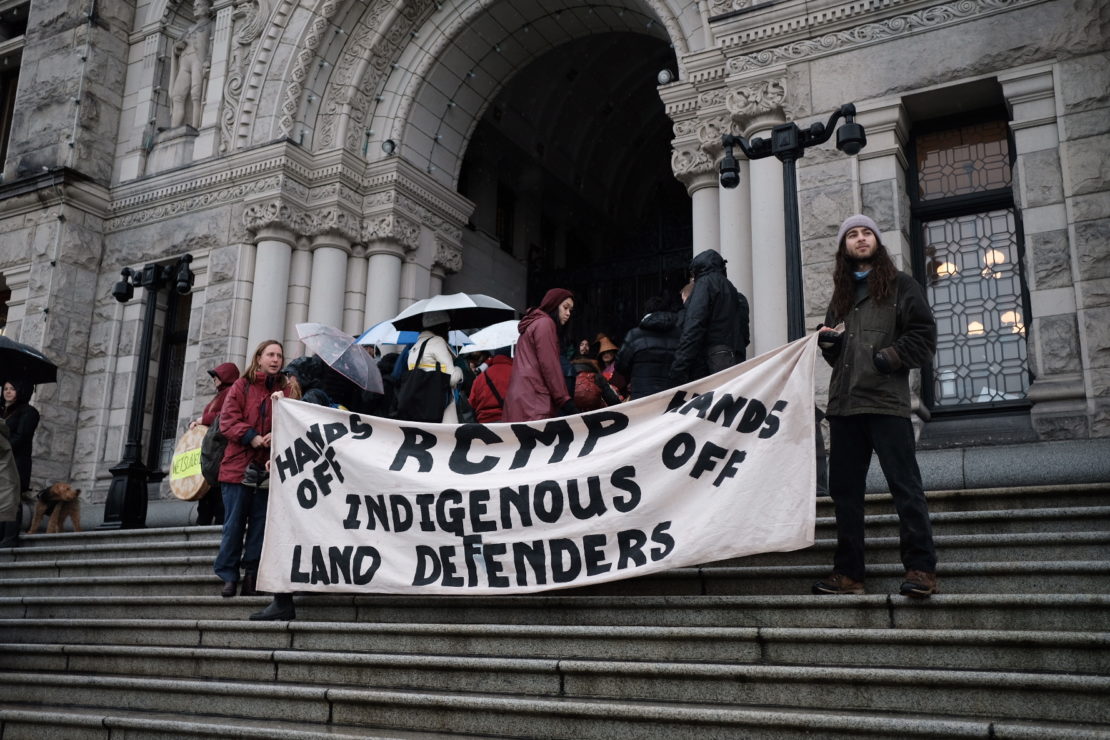It’s about hundreds of years of colonial violence

At the B.C. Legislature on Feb. 11, the story of the day was supposed to be the Speech from the Throne. Instead, all 16 entrances of the building were blocked by Indigenous land defenders and allies — some of whom had been sleeping on the front steps for six days.
Indigenous youth, elders, and allies knocked on the symbolic door of colonial government — the Ceremonial Entrance intended only for the British crown, demanding that B.C. concede to the demands of Wet’suwet’en’s Hereditary leadership. The Lieutenant Governor, blocked from entering through the Ceremonial Entrance by the occupation, was smuggled into the legislature through tunnels from neighbouring buildings.
Headlines called it an “anti-pipeline protest.”
Simplifying this issue to a pipeline protest is politically convenient. It fits into pre-established ideas of economy versus environment, people versus profits, and government-backed fossil fuel corporations versus disruptive protests. The Canadian media, and Canadian public, can roll with this narrative.
However, if you look past most coverage, it becomes clear that movement isn’t, at its core, about the pipeline at all. The Wet’suwet’en have been working to reoccupy their territory since 2010, when Unist’ot’en Camp was founded, and to them, this is a struggle for sovereignty.
A focus on Indigenous sovereignty requires contextualizing the issue within settler colonialism which makes the story less digestible for the average Canadian scrolling through their Facebook feed. Ignoring Indigenous sovereignty in this case, however, is perpetuating a colonial outlook that Indigenous ideas are subservient to our own understandings.
To the majority of the Canadian public, the fight against Coastal GasLink’s (CGL) Liquified Natural Gas pipeline seems like a contemporary struggle, an environmental issue, even. For the Wet’suwet’en, and for Indigenous peoples across Canada, this battle is only the most recent in a struggle as old as European settlement on the continent.
Canada’s existence is actually a relatively new development in Wet’suwet’en history. The “democratic” system of government brought by the Indian Act and reserve system and forcibly imposed by the Canadian state was attempting to push out a hereditary system of governance that far predated European colonization. The Delgamuukw case affirmed the land rights and title of hereditary chiefs in 1997, yet over 20 years after that 1997 decision, these important questions of Aborginal title and band council versus hereditary chiefs are still up in the air for the Wet’suwet’en.
Because these things were never resolved, the situation became — as John Horgan called it — “complex.”
It’s convenient, however, to suggest that this is an unresolved issue between Indigenous systems of governance while at the same time plowing through their land to advance an energy project. The hereditary chiefs had actually proposed a different pipeline route, but Coastal GasLink rejected it for financial reasons.
For the Wet’suwet’en, this pipeline was the last straw. It’s relevance to the story is contextual, not central.
Whether or not the Wet’suwet’en have authority over their land is not complicated under Wet’suwet’en law and it doesn’t have to be complicated under Canadian law. The court case is from 1997 — the government has had 20 years to recognize their Aboriginal title.
Regardless, the fact that the issue of title, rights to land, and governance systems are complicated and unresolved in Canadian law does not give the RCMP the authority to arrest unarmed Indigenous people at gunpoint and use unnecessary amounts of force. The RCMP literally sawed apart a sign that said “reconciliation” to enter the Unist’ot’en camp. The Indigenous youth at the Legislature proclaimed “reconciliation is dead,” and the RCMP held the smoking gun.
Instead of a story that includes centuries of Indigenous self-governance, the Canadian public has been spoon-fed a pipeline-focused narrative that insinuating the hereditary chiefs are undemocratic, that band councils approve the project, and framing Indigenous land defenders as protestors disruptive to Canadian progress.
Ultimately, Indigenous rights do not get decided by the court of public opinion. But Canadians may be the only ones who can (as many are attempting) hold their government accountable to recognition of Indigenous sovereignty and the real issues at stake here.
What’s happening in Wet’suwet’en should be a warning to us all: reconciliation is as we know it is dead, and that to our government, human rights are always second to economic progress.








